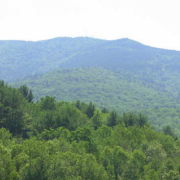Conservation and Trails: Reflections Regarding Closed Trail in Plainfield
May 24, 2013
Jeanie McIntyre, President
Pete Helm, VP of Stewardship
A Plainfield trail across conserved land has been closed and the community is riled up. A front page newspaper story put the spotlight on the intense conflict as the landowners and trail builders traded accusations in a very public forum. For those readers who may have been wondering whether the recent controversy relates to a UVLT conservation project or trail, we begin with a clarification: UVLT is not a party to the conservation easement and did not build the trail. Our reflections here are not intended to provide legal interpretation or assign blame, but the difficult situation prompts us to share our thoughts about the benefits and risks of trails on conserved land.
Public access is one of the public benefits potentially provided when land is conserved. (Some, but not all, conservation easements include access provisions or establish public trail rights.) Other public benefits of land conservation derive from natural resource factors: productive soils, clean water, wildlife habitat, flood storage, carbon sequestration, scenic beauty etc. Trails rarely, if ever, enhance these natural resource values. Trails do not improve soil or encourage better forest growth or increase wetland functions. Trails can bring sunlight to the forest floor, spurring the growth of invasive plant species. Pedestrians and their dogs can stress wildlife.
On the other hand, trails can provide indirect benefit to natural resources. Trails bring people outside where they can enjoy the natural world and learn about stewardship. When public trails are available, outdoor enthusiasts are less likely to feel they need to purchase their own property for recreational purposes. Well planned and appropriately maintained trails can discourage the fragmentation of habitat and encourage environmental responsibility. We believe that public trails are a vital part of a community-based land conservation strategy.
To accommodate both natural resource protection and public recreational use, conservationists must carefully assess the possible impacts and risks posed by trails. Is there a strategy for mitigating potential harm? Is there the capacity to implement mitigation measures, including trail relocations or closures, if needed? Is the trail manager prepared to proactively educate users about the lands through which the trail passes – to develop awareness and good stewardship practices on the part of trail users? Is the trail manager aware and supportive of the landowner’s rights to manage the conserved land surrounding the trail and prepared to resolve concerns before they become problems? All of this takes a huge investment, not just when the trail is built, but for years to come.
Many conservation groups are unwilling to build trails or accept responsibility for trails unless they have obtained permanent corridor easements. They won’t devote the time of volunteers and staff or spend organizational capital on a trail that could later be blocked or converted to another purpose. They commit to and prepare for the sustainability of the trail, anticipating that land uses, landowners and recreational demands will change over time.
It appears that Plainfield’s trail builders invested significant effort and community goodwill in constructing a trail for which they had not obtained a legally binding corridor easement from the landowner. The landowner apparently allowed cutting and marking for the trail at one point in time, but there was no guarantee for the continuation of those activities.  It is unfortunate that the trails group spent their time and manpower to create a trail that will not be sustained. We can appreciate the disappointment of trail users who are deprived of a trail they’d enjoyed.
We hope the unfortunate conflict in Plainfield encourages outdoor enthusiasts throughout the Upper Valley to consider the trails they enjoy: How were these trails created? Who is maintaining them? Is there an adequate plan for management and long term sustainability? Trail users have a vested interest in supporting the groups that protect trails and provide trail stewardship. Without a binding trail easement and the funding and volunteer support to care for trails over time, your favorite trail could be one misunderstanding away from closure. Â If you hike, run, ski, bike, or snowshoe on public trails, help the conservation groups that protect them forever.


